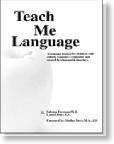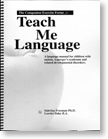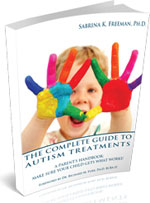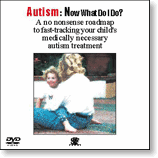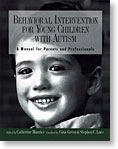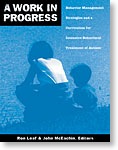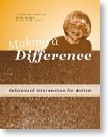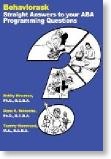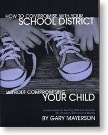What Keeps You Up At Night?
I had the privilege of sitting on the panel for the Association for Behavior Analysis International (ABAI) conference in Oregon in January. The last day of the conference was devoted to parents. Parents on the panel were asked to address an important topic.
Question: What Keeps You Up At Night?
Since I’ve been thinking about this rich topic for a long time, I thought I’d share the thoughts I presented at the ABAI conference, in their entirety. The presentation is posted below.
____________________________
What keeps me up at night? That’s a very rich topic, and you’re looking at an insomniac! If I could sum up in a phrase, it would have to this: JUNK SCIENCE.
Why should parents care about junk science?
The concern is that Junk Science will win the autism treatment war and successfully block effective treatment for children with autism. This would have ramifications for children not yet diagnosed, just diagnosed, or already in effective treatment programs.
In other words, Intensive Behavioral Treatment based on the principles of Applied Behavior Analysis, is going to be replaced by ineffective programs that will be served up by the 1000’s of treatment purveyors who are masquerading as legitimate, effective treatment professionals.
Why do I see things in such a negative light? Here are some very dangerous trends:
Junk Science is becoming more sophisticated
When my child was diagnosed over twenty years ago, there was no shortage of quackery. But when a parent asked for scientific studies, if the quacks were organized, they’d supply newspaper articles or testimonials, but no studies in peer-reviewed journals. Twenty years later, treatment quackery is published in poor-quality journals, some of which are written by academicians. In addition, there are now books full of uncontrolled case studies, which are no better than testimonials but come with a patina of legitimacy.
Convergence
The second trend I see is what I’ll refer to as convergence. In this case, a number of treatments that have never had any scientific support are combined and offered in an eclectic program. This often masks the fact that there is no data that demonstrates treatment efficacy, and thereby fools parents of newly diagnosed children into evaluating the treatment program as worthwhile.
An even more problematic issue are the treatments with no decent data outcomes that sprinkle a little behavioral treatment into their program and then compare their program to what is available in the community, which is generally general special education, which is not typically optimal for children with autism. So now substandard treatment competes with glorified babysitting. In this false contest of autism treatment, the treatment with a modicum of ABA that is being tested will outcompete the control.
Although it may be politically incorrect to say, this is the big problem with the Early Start Denver Model. In 1987 – 1998, the Denver Model (originally cased the “playschool”) did not present itself as a behavioral treatment program for autism. Back then, the “Playschool” was primarily play therapy. The Early Start Denver Model now incorporates ABA. They published a 2010 study where they took:
“Forty-eight children diagnosed with ASD between 18 and 30 months of age were randomly assigned to 1 of 2 groups: (1) ESDM intervention, which is based on developmental and applied behavioral analytic principles and delivered by trained therapists and parents for 2 years; or (2) referral to community providers for intervention commonly available in the community.”
Now these researchers created results showing how great their model is as compared to glorified babysitting. Why should we care? We should care for two reasons:
First, this wastes our children’s valuable time with treatments that are diluted at best and we know that diluted treatment doesn’t create best outcomes. Over twenty-five years ago, Lovaas (1987) demonstrated sub-optimal outcomes when he provided highly quality behavioral treatment to a control group for 10 hours a week.
Based on their research, the Early Start Denver interventionists seem to be overly concerned with saving money on the backs of our kids. They seem to be interested in a) less intensity that costs less, b) parents as therapists aka free labor, and c) long distance training of therapists which costs less. The unifying theme appears to be “let’s save money”, not “what works best” for the kids.
Of course, I have no issue with providing quality treatment more efficiently; however, before trying to save money, researchers in other fields first attempt to create the best treatment for the malady they are targeting. To illustrate, cancer researchers aren’t thinking about saving money when they develop innovative treatments for cancer. Why are children afflicted with autism somehow deemed to be children of a lesser god, where economizing on treatment is more important than effectiveness?
Academic literature reviews
The 3rd trend that keeps me awake at night are the growing number of so-called academic literature reviews on autism treatments. Governments rely on these reviews to make decisions about whether to fund intensive behavioral treatment. Many of these so-called “independent” reviews are generally created by health care economists whose job is, essentially, to save gov’ts money by only funding what they, in their gate keeper capacity, deem to be science-based treatments. That sounds great until you understand that this group of health policy analysts is either:
In the back pocket of gov’ts with government owned medicine such as Canada, the U.K., or Denmark, or
Honest in their mission but do not understand the politics of the autism wars and are influenced by their international colleagues who may have a darker agenda, like the British Columbia Office of Health Technology’s shameful work against kids with autism in Canada’s landmark Auton case for publicly funded autism treatment.
Due to the highly politicized nature of this area, the consumer should not put any trust in any literature reviews on autism treatment. Before believing any recommendations, the informed consumer should go directly to the source article. Unfortunately, most people trust these health care economists who are in the business of rationing treatment. It’s analogous to having the fox guarding the chicken coop.
In the U.S., parents have been wildly successful at lobbying and litigating against health insurance companies. The autism lobby has also been very successful in getting autism mandates passed in the majority of states that require autism treatment to be covered by the insurance companies in that state. However, these academic literature reviews are dangerous because they are calling intensive behavioral treatment “experimental” which is the “get out of paying for it” card used by health insurance companies, whether private or government owned. This this fraudulent health policy trend is going to block our children from access to intensive behavioral treatment.
That’s what keeps me awake at night.
*This talk was originally presented at the Association for Behavior Analysis International (ABAI) conference in Oregon, Sunday, January 27th, 2013.
The Latest Academic Justification to Ration Treatment is a Doozy
Here’s the summary.
Fountain and colleagues followed almost seven thousand children diagnosed with autism born in California, from 1992 through to 2001. Then they created six “trajectories” in an effort to predict how well the children will progress based on various dimensions. Although this article is full of findings that may be disturbing to parents for a variety of reasons, in my view the most dangerous findings have to do with intellectual disability and where the mother was born! The researchers found that:
“Having an intellectual disability was strongly associated with LF (Low Functioning) trajectories, as was having a foreign-born mother. Finally, children of white mothers were less likely to be LF than bloomers, as were children of Hispanic mothers (relative to nonwhites).” p. e1117
Allow me to translate: if your child at diagnosis is given an IQ test and does not score in the normal range, and/or if you are a foreign born mother, watch out! Those rationing treatment may use this article to deny your child treatment. Immigrant parents need to be particularly vigilant!
Luckily, there is one finding that can be used to argue against those rationers: The Late Bloomer. In this article, they found one group of children who are late bloomers. These children,
“… most likely to “bloom” are those without intellectual disability and those with more educated, non- minority mothers. Although we are unable to identify the specific mechanisms through which socioeconomic status affects trajectory outcomes, the intervening variables likely include home and neighborhood environments, quality and intensity of treatment, quality of education, the efficacy with which parents are able to advocate for their children with institutions providing services, and many other factors in various permutations.” p. e1118
In other words, if the child’s IQ was typical at diagnosis, and parents were better advocates with money to purchase superior treatment services, their children improved significantly.
So what do we do about the IQ tests? My view is since IQ testing is so wildly inaccurate when it comes to young children with autism, it seems criminal to seal their fate with a socially constructed test that has a decades-long history of being discriminatory in its impact.
What about minority or immigrant status of the parent? When it comes to the parent’s minority status, that’s when the discrimination becomes explicit. In short, if you smell discrimination, let this article alert you to protect yourself and your child! If you are in a minority, make sure that you find an advocate to write letters for you and attend meetings with you about your child. Keep this article in your back pocket if you suspect that your minority status is influencing the treatment or placement services of your child. When you demand equal treatment for your child, the system will be more likely to listen to you if you have evidence from a peer-reviewed journal that discrimination against children like yours has been going on for decades.
A "How To" Guide for Autism Junk Science
Here’s the background.
The Ontario government has created a set of benchmarks to monitor progress and facilitate clinical decision-making for children in behavioral autism treatment programs. In the vernacular for the rest of us who are outside of government-based healthcare or social services, “benchmarks to facilitate ...decision-making”, means rationing of care. The general idea is to deny ongoing treatment for children with autism who don’t progress quickly, per a set government-approved schedule. This, of course, is to the benefit of the public purse at the expense of children with autism.
Regrettably, this article, Testing the Application of Benchmarks for Children in Ontario’s IBI program: Six Case Studies, is now being used to ration autism treatment in the Province of Ontario. Ontario’s method for rationing treatment can only work if junk science is credibly crafted and packaged with faux legitimacy.
Here’s the “how to” ... 5 easy steps to junk science, using the Government of Ontario’s latest gambit as an illustration (although this works equally well in any country with socialized medicine):
- Create a substandard patchwork of programs to treat children with autism, but slap a label on them that reads, “Intensive Behavioral Treatment (IBI).” In other words, use the language of science for programs that are utterly devoid of it.
- Non-randomly observe six children who have completed the substandard, government IBI program (the “direct service model” staffed by government workers). Then use a “case study” method to measure the progress of these children, since scientific rigor is too difficult and costly, and harder to manipulate by self-interested government technocrats. Do not include children who are in high quality programs since it would be inconvenient to provide evidence that children make considerable progress in non-government controlled, privately run programs.
- Create “benchmarks” for terminating treatment based partially on American benchmarks that were not rigorously peer-reviewed. These local so-called “Made in Canada” benchmarks provide government the tools with which to fail kids with autism and thereby prematurely end treatment i.e., ration care.
- To six children, apply these government benchmarks, created by government-owned academics who receive a variety of research contracts directly from government departments and are government witnesses testifying against children with autism in court. Then provide bogus evidence regarding the efficacy of the government funded benchmarks.
- Publish the “evidence” as to the efficacy and appropriateness of these benchmarks in a third-rate Canadian journal where one of the two authors happens to be on the editorial board and the other is the treasurer of the association that publishes the journal. The corrupt academic article then provides scientific legitimacy for government lawyers when these benchmarks are challenged in court.
And Viola!
You’ve created government-approved junk science in five easy steps. Let’s hope Ontario judges are onto this corrupt game and remember what happened the last time junk science was introduced in a Canadian court to defend the Government of British Columbia against the serious charge of constitutional discrimination against children with autism. Dishonest academics in bed with dishonorable government is as ugly now as it was during the landmark Auton Case.
Parents as autism therapists - a morally bankrupt policy!
The bogus legitimacy given to the “parent as therapist” model has been around for a long time. The logical allure for government is to have policy makers conscript free parent labor as this saves governments and health insurance companies money. Savvy parents have understood this dynamic and have fought to have professionalism brought to autism treatment. Many have insisted on the use of board certified behaviorists with expertise in autism.
In the case of the parents referenced in the article, the government efforts have met with success. Parents have completed a course that the reporter calls “innovative” because parents of children with autism can graduate with a course certificate after having been taught by a nurse with only a minimal background in behaviorism! The fact that these parents are so thrilled with a course that teaches them very basic tools to deal with their children with autism is disturbing since that means that they are getting no professional treatment for their child’s condition. Imagine if parents of children with cancer took classes from nurses on how to treat their child’s cancer! This would be considered scandalous, but where autism is concerned, the children of a lesser god can be denied professional care, be offered “good enough” and reporters cheer! Parents, your children deserve better!
When researchers are duped by policy wonks
In the same way as Cancer researchers do not routinely recommend denial or rationing of treatment based on the progression of the Cancer, neither should autism researchers predict the efficacy of treatment for hypothetical children based on their limited studies regarding the effectiveness of treatment after a discrete amount of time. The moment these researchers dive into the murky waters of prediction of an individual child based on their research, they have become advocates instead of researchers. They have in a brief moment moored from pure researchers into policy wonks.
What am I talking about? I’m referring to the rich history of denial of services based on researcher testimony.


